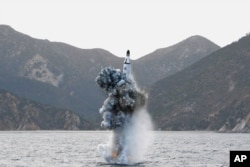The U.S. and South Korea have announced plans to deploy the Terminal High-Altitude Area Defense - THAAD - on the Korean peninsula to counter North Korea’s ongoing nuclear and ballistic missile development programs.
General Thomas Vandal, the chief of staff for U.S. Forces in Korea, and South Korea’s Deputy Minister of Defense Ryu Je-seung made the formal announcement during a joint briefing in Seoul Friday.
“North Korea’s continued development of ballistic missiles and weapons of mass destruction, in opposition to its commitments to the international community, require our alliance to ensure that we retain the ability defend ourselves in the face of this threat,” said Gen. Vandal.
In February following North Korea’s last nuclear test and launch of a long-range rocket using ballistic missile technology, Washington and Seoul began formal consultations to discuss the feasibility of deploying THAAD.
“The joint task force team of two countries has confirmed the military effectiveness of THAAD to be operated in the Republic of Korea, and is working on final preparations to propose to defense ministers of both countries the best site where this THAAD system will be effective and where environment, health and safety can be ensured,” said South Korea’s Deputy Minister Of Defense Ryu Je-seung.
THAAD is designed to intercept and destroy ballistic missiles during their final, or terminal, phase of flight. It has so far proven effective against short- and medium-range ballistic missiles.
Arms race
China on Friday reiterated its strong opposition to the U.S. THAAD deployment in South Korea and urged the two countries to put a stop to it. China's Foreign Ministry summoned the American and South Korean ambassadors to lodge complaints.
Beijing’s Foreign Ministry said the missile defense system deployment is not beneficial to maintaining peace and stability on the Korean peninsula and will seriously harm the security of countries in the region, including China.
Beijing has in the past raised concerns that the THAAD radar system would be used to penetrate Chinese territory.
Moscow has also slammed the defense system, warning Friday it will have "irreparable consequences" and will escalate regional tensions.
Pyongyang also lashed out at the U.S. and South Korean announcement.
A U.S. Defense Department statement issued Friday says "When the THAAD system is deployed to the Korean Peninsula, it will be focused solely on North Korean nuclear and missile threats and would not be directed towards any third party nations."
North advancements
U.S. and South Korean defense officials say North Korea’s continued advancement in developing its nuclear and missile capabilities in defiance of U.N. sanctions has prompted the alliance to move forward with the THAAD deployment, despite China’s reservations.
Last month Pyongyang launched a partially successful test of an intermediate-range Musudan missile. Although the missile flew approximately 400 kilometers before falling into the sea, there were indications the North Korean military had or is close to developing the capability to reach U.S. military bases in Asia and the Pacific
North Korea is believed to have 30 Musudan missiles and 1,000 other Soviet model missiles that can reach targets in South Korea and Japan.
U.S. authorities have also said they believe North Korea has enough plutonium to make eight to 12 nuclear weapons and the ability to miniaturize a nuclear warhead to fit on a KN-08 long-range missile, although this capability has not yet been demonstrated.
UN sanctions
Since 2006 the United Nations has imposed increasingly stronger sanctions on North Korea for continuing to develop its banned nuclear weapons and ballistic missile program.
This year the U.N. Security Council imposed tough new measures that include suspending currency transfers and restricting the North’s lucrative mineral trade after North Korea conducted its fourth nuclear test in January.
Youmi Kim in Seoul and VOA Pentagon correspondent Carla Babb contributed to this report.












